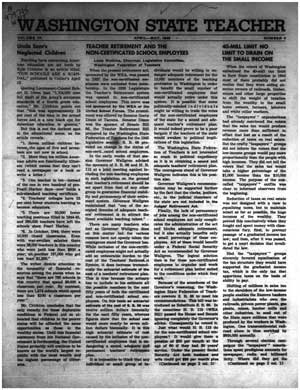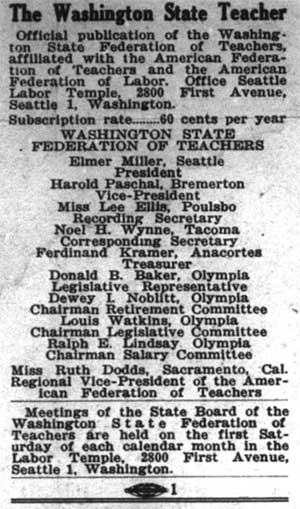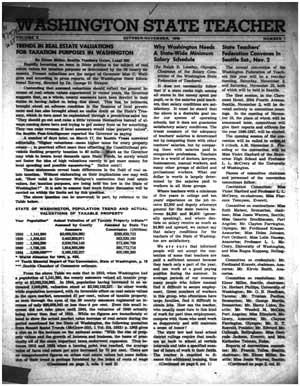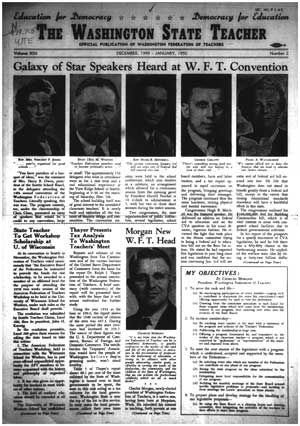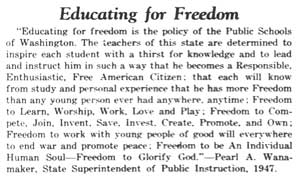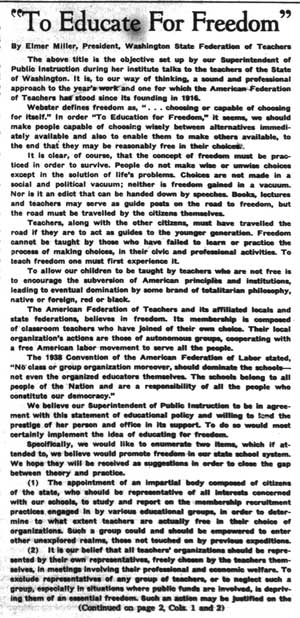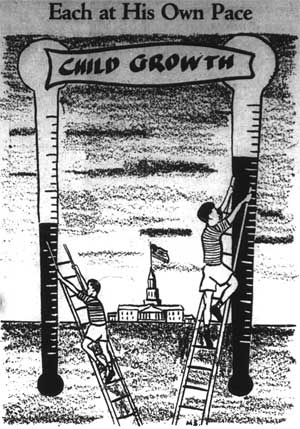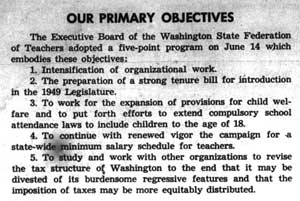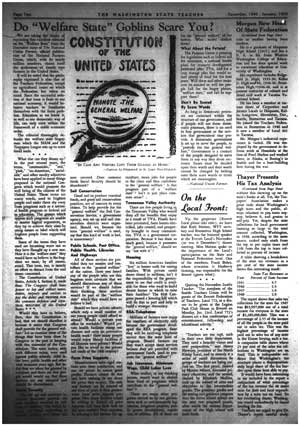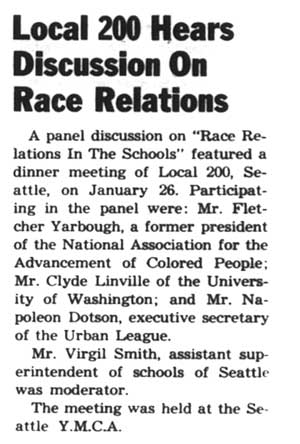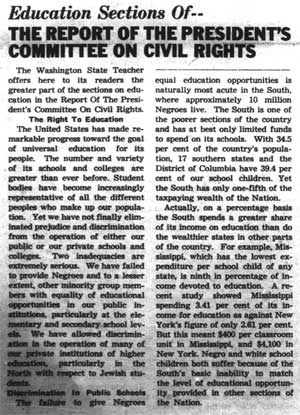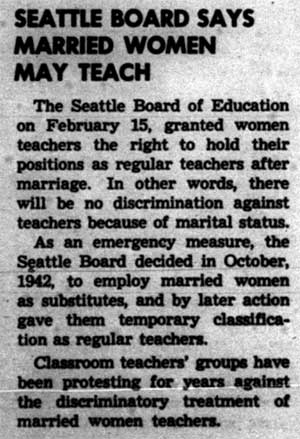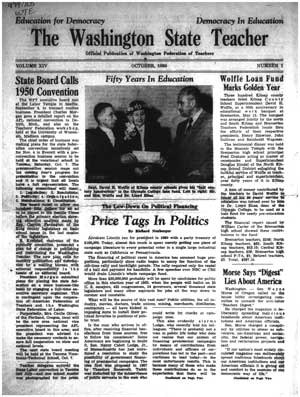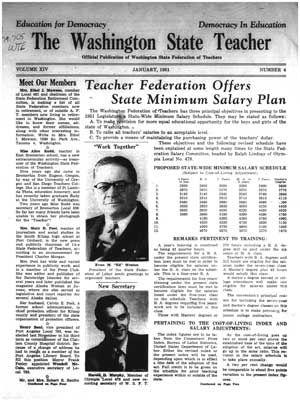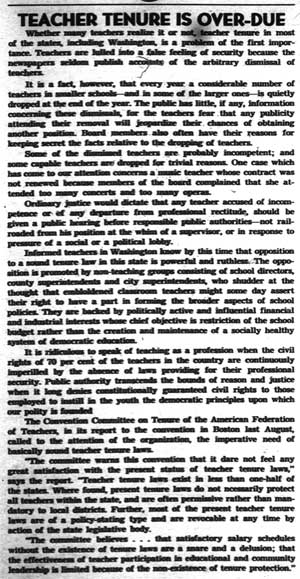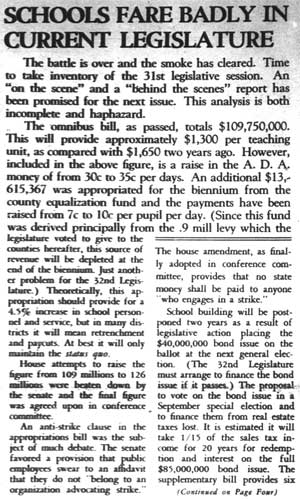The Washington State Teacher
|
Report by Trevor
Sargent
"Education for Democracy, Democracy for Education" Abstract: The Washington State Teacher was the official organ of the Washington State Federation of Teachers (WSFT), which was allied with the American Federation of Teachers (AFT) and the American Federation of Labor (AFL). As a result, the paper had a two-fold objective: to strive for the betterment of public education and to advance the organized labor movement. This report focuses on the publication from October–November 1945 until January 1951. Affiliation: Washington State Federation of Teachers (WSFT), American Federation of Teachers (AFT), American Federation of Labor (AFL) Dates Published: February 1937 – May 1968 Frequency, Size: Bi-Monthly; Changed to Monthly in October 1950 – 4-8 pages Subscription: $0.60 per year Circulation: 6,000 (December – January 1949-1950, p.3.) Collection: University of Washington Libraries, Microform and Newspaper Collections: [A7180]
The Washington State Teacher, originally titled The Washington Teacher (changed November 18, 1941), was the “official publication of the Washington State Federation of Teachers, affiliated with the American Federation of Teachers and the American Federation of Labor.”[1] The American Federation of Teachers (AFT) was founded on April 15, 1916 and it joined the American Federation of Labor (AFL) almost a month later on May 9, 1916. [2] For the first few decades of its existence the AFT granted local charters to groups of seven or more professionally qualified teachers for a fee of $10. The Washington State Federation of Teachers (WSFT) was chartered by the AFT in 1935. The first edition of The Washington State Teacher was printed on February 13, 1937. As an organ of both dedicated teachers and committed unionists, the paper had a two-fold objective: to strive for the betterment of public education and to advance the organized labor movement. This dual objective was summarized by the official motto of the AFT, which was printed across the top of every issue: “Education for Democracy, Democracy in Education.” The newspaper was in circulation from February 1937 until May 1968. However, many collections of the paper, including the one in The University of Washington’s holdings, are incomplete. This makes obtaining a consistent stream of information difficult and it is hard for historians to follow stories that lasted longer than two months and find complete lists of WSFT elected officials and editors. Nevertheless, it is still possible to discover The Washington State Teacher’s overarching themes and study issues reported in the newspaper. This essay will focus on the paper’s publication between October-November 1945 and January 1951, the most complete consecutive years in the collection. The first edition contained an editorial from WSFT president Hugh De Lacy, in which he stated that The Washington State Teacher would present readers with reports on the state of public education, the WSFT and AFT’s efforts to improve public education, and news of the labor movement. But most importantly, De Lacy stated that The Washington State Teacher and the WSFT would work to improve the professional status and economic position of teachers: "My warmest fraternal greetings to the first edition of our paper. May it be the voice of the classroom teacher, an honest and independent expression of the difficulties our profession has endured too long in silence. May it arouse and give direction to the native energy and intelligence of our teachers and encourage them to rely on themselvs [sic] and their own organizations to solve their problems." The American Federation of Teachers and this, its Washington organ, are dedicated to the principle of Democracy in Education and Education for Democracy. We believe that teachers must be well trained, well paid, not overburdened, secure in thir [sic] positions, and protected against intimidation and coercion. Timid, overworked, and ill-paid teachers will not produce the kind of citizens America needs. An enlightened citizenry can build a free and prosperous nation. We must do our part in this great process, and to protect ourselves against the organized opposition of the tax-dodgers and cost-cutters who would close all free public education above the eighth grade and drive every critically-minded teacher from the profession, we must ourselves organize. We must join and build our own classroom teachers’ organization, the American Federation of Teachers."[3] The Washington State Teacher remained devoted to De Lacy’s aims for the duration of its existence The paper was run by members of the executive board of the WSFT who were elected in regular intervals at local conventions. The editor was not listed for many years until Ralph C. Johnson was noted as editor in 1947. A year later the editor was listed as R. E. Kvelstad until the official name of the editor was removed in the October 1950 issue. The full list of the elected officials was regularly printed near the end of each publication. Delegates of the locals attended the rotating conventions to vote on various resolutions and issues of importance to the union. Membership dues (set at a minimum rate of $1.50 a month) and the subscription price of the paper ($0.60 a year) funded the conventions and publication. The newspaper was virtually void of advertising. For the most part, The Washington State Teacher limited itself to national issues. In addition to union news, the publication consistently addressed issues of the education system, civil rights, salary increases, retirement, tenure, and taxation. The paper printed “Our Primary Objectives” in 1947 and listed them as: “1. Intensification of organizational work 2. Preparation of a strong tenure bill for 1949 legislature 3. Child welfare and lengthen compulsory school attendance to the age of 18 4. Minimum salary schedule 5. Revise Washington tax structure to end some of its regressive features.”[4] Since The Washington State Teacher was a labor newspaper, solidarity was a central theme. This principle was exemplified in an article regarding a House Resolution bill on social security that had little effect on teachers in Washington. Nevertheless, the newspaper urged support for the bill because it would extend benefits to more than 35 million people. The WSFT, the paper argued, “is interested in working to help others improve their positions.”[5] Many articles were printed that pertained to national charters of the AFT. as well as the labor movement as a whole. Additionally, the newspaper reprinted articles from other publications if they pertained to education or fell in line with the aims of the WSFT. The editorials were at times an open forum for discussion, inviting criticism and arguments from outside sources. Lengthy reports were printed on all the national AFT conventions, WSFT conventions, and local W.S.F.T. meetings. “On the Local Front” was a column added in 1948 to specifically cover news from Washington locals. The WSFT was very concerned with legislation that affected unions, and accordingly they fully supported the Wagner Act of 1935.[6] Similarly, the WSFT adamantly opposed the Taft-Hartley Act of 1947, which amended the Wagner Act and hurt workers’ ability to form unions. An editorial discussed the political impact that Taft-Hartley would have on teachers: “The Taft-Hartley Act provides no restrictions on political activities of teachers as individuals. It does, however, restrict the right of unions, including teacher unions, to engage in political activities.”[7] To further show its disdain for anti-union legislation the paper ran an article entitled, “The Real Monopoly is Not Labor,” in which Representative Kauver of Tennessee wrote, “What the American people have most to fear is not the unionizing of workers. Rather, it is the combination of forces that control the industrial and financial resources of the nation which they are continuously channeling into fewer and fewer hands; they constitute the monopoly power which, practically unchecked…is a living menace to American democracy.”[8] Moreover, President E.M. Weston of the WSFL reiterated unionized teachers’ opposition to anti-labor legislation when he told teachers at a state convention that it is the “sincere intention of the American Federation of Labor to save the labor movement from the Taft-Hartley Law whose aim is to shackle labor and then to strangle it.”[9] The Washington State Teacher was critical of anti-union legislation, but it also saw the government as the most viable avenue for improving education. But in its attempts to procure more funds for public schools, the WSFT encountered opposition from many groups. Among these, the paper called the Washington State Taxpayers Association, a conservative group which tried to curtail public spending, “the greatest enemy of the public school system.”[10] The WSFT was officially non-partisan, but it supported elected officials, most often democrats, who voted favorably for education and teachers.[11] The Washington State Teacher urged teachers to be politically active and exercise their rights as citizens. An amendment to the Hatch Act in 1942 allowed teachers the right to act as political citizens.[12] As one editorial noted, "Much energy has gone into conditioning teachers against getting their hands soiled in political turmoil and horrible examples can be cited of where they have lost their virtue as well as their jobs for venturing into the fray…Today, to ignore and neglect the financial problem, means extinction for the profession and suicide for education… Influencing public officials spells politics. Experience proves it easier to elect a senator friendly to the schools than win a disinterested or agnostic one over. What are you going to do about it?"[13]
From 1945 to 1951, in addition to legislative news, The Washington State Teacher reported on many other issues important to teachers and union members. The education system’s role in the struggle for civil rights was covered in great detail. , the paper also reported on the “baby boom” of the post-war years. The sharp demographic increase in birth rates and young children created a major shortage of teachers. The paper argued that without increased funding and new teachers the education system would quickly become crippled. The shortage existed even after a ban on hiring married women teachers was lifted and extended beyond the end of the war.[14] Also, the end of WWII and ensuing Cold War climate greatly limited the academic freedom of educators and WSFT teachers came under attack. Attention to Race “When we banish our grandiose pretensions and achieve real democracy the hiring of Negro school teachers will cease to be a newsworthy event.”[15] The Washington State Teacher was a very progressive organization in its view of race and civil rights. The paper went to lengths to report on many national issues involving African Americans and education, consistently upholding a belief in equality. A guest article in 1945 from the Civil Liberties Quarterly, “Negro Teachers Win Equal Pay Case In U.S. Circuit Court,” reported on a case in St. Paul, MN in which the U.S. Circuit Court ruled for equal pay for teachers, regardless of race. Judge Seth Thomas stated in the court’s decision that “The explanation (by the school biard [sic]) that substantially all colored teachers are worth less than substantially all white teachers: that the basic salaries of colored teachers are accordingly lower than the basic salaries of white teachers; and that it is therefore logical that public funds should be distributed to them on a percentage basis is not substantiated by the evidence.”[16] Another article printed a few months later discussed an education plan utilized in Chicago that attempted to “utilize the resources of education to combat the growing menace of race prejudice.” The idea was to present the basic scientific facts of race to the “unwarped minds of adolescents,” with the assumption that scientific knowledge “is often rejected by adults when it is in conflict with their cherished prejudices.”[17] The same issue printed an article on black schools in Georgia, reporting that unequal access to education was “due to denial of economic equality, and that given equal chance at making a living and procuring an education, they would prove their equality in culture, workmanship and standard of living.”[18] The Washington State Teacher seemed to be equally troubled by the lack of civil rights in the Pacific Northwest. In May, 1947 ran an edition with the headline, “Lawmakers Fail Second Time to Outlaw Anti-Race Practice” in the Washington State Legislature.[19] When it came to teachers’ role in the civil rights struggle, the paper kept readers abreast of how educators might assist in the battle for equality. Over the course of two issues, the paper printed excerpts from the President’s Committee on Civil Rights. Although the committee proposed universal education for all, The Washington State Teacher felt that the committee fell short in many respects. “There is a marked difference between the educational opportunities offered white children and Negro children…Negro students are invariably at a disadvantage.”[20] The WSFT’s stance on the inadequacies of public education in the realm of racial equality was also captured in a political cartoon, “Behind the Wooden Curtain.” The cartoon portrayed a classroom of white students on a few benches in front of a class, and off to the side behind a wood panel divider sat an isolated black man equally intent on listening to the information. Tacking a different tract, a writer from the New Jersey Teacher questioned what the world must think of a segregated school in America, which purports itself to the world as a beacon of democracy in lieu of the Cold War.[21] Overall, these examples show that The Washington State Teacher and the WSFT were committed to racial equality in education. Moreover, these union members attempted to use their status as educators to address these issues. At Odds With the NEA and WEA The AFT and the National Education Association (NEA) had been in conflict since the AFT’s creation in 1916 . The AFT argued that the NEA was fearful that the union movement would eclipse their organization. On the other hand, the NEA asserted that union teachers were unprofessional and organized labor hurt the status of educators.[22] In an article titled “The N.E.A. Drops a Dud,” a representative from the WSFT wrote, “…the N.E.A. Journal, official organ of the National Education Association, chides the union teachers for ‘attaching themselves to labor rather than to the professional organizations which have served them for a hundred years, patiently building teaching up to the standards it now enjoys’” The WSFT quickly countered that “No group in America has been more loyal to public schools than labor…The Journal’s dismal prediction that… the alliance of teachers with labor will bring ‘disastrous results to the teaching profession’ has not materialized and there is not the slightest indication that it ever will.”[23] In the conflict between the AFT and NEA, one of the primary purposes of The Washington State Teacher was to correct misinformation and refute attacks directed towards organized labor. Articles went into great detail to address misinformation on a point-by-point basis on topics such as retirement, salary schedules, and school appropriations.[24] For example, the WSFT used the Washington State Teacher to adamantly deny NEA representative Pearl A. Wanamaker’s claims that labor strikes had regressive impacts on education.[25] WSFT members also used the paper to go on the offensive. In a series of articles, WSFT representatives claimed that the NEA served the interests of big business. The paper was especially wary of the NEA’s close association with the National Association of Manufacturers. “Control of public school systems by business and industry,” said WSFT President E.M. Weston in a convention speech reprinted in the paper, , “is at once inimical to education and a challenge to organized labor.” He continued by describing “teachers’ associations” affiliated with the NEA as company unions which are largely dominated by business interests.”[26] To further combat misinformation, The Washington State Teacher utilized the editorial section to print “open letters,” encouraging conversations with the NEA. Most often, the newspaper would reprint statements delivered by the NEA and publish responses. However, no rebuttal letters were ever printed, if ever received, on behalf of the NEA. Political Freedom, Academic Freedom, and the Red Scare In the post-war years, The Washington State Teacher published many articles that argued teachers’ political freedom needed to be protected. The paper reprinted a resolution that was adopted at the 32nd annual convention of the AFT, which stated, “In circumscribing the civil liberties of any group in society, we limit the civil rights of all groups and do lasting damage to the traditions and principles of American democracy. We hold, therefore, that membership in an organization or in a legal political party is not in and of itself sufficient grounds for the dismissal of a teacher.”[27] In the Cold War years, academic freedom came under attack and educators from across the country began to report that they had been unfairly persecuted for teaching unpopular views or information. The WSFT used The Washington Teacher to decry these attacks. The paper printed a letter from Rose Russell, legislative representative for the New York City teachers’ union, which said, “Under severe attack throughout the country today is that basic tenet of education in a democracy: THE RIGHT TO PURSUE TRUTH FREELY. Freedom of students to learn and of teachers to teach is everywhere directly threatened.” A reprinted bulletin from the Los Angeles Teachers’ Federation stated, “A ‘loyalty check’ can serve no purpose other than to fan the very flames of fear and hysteria that engendered it…A ‘loyalty check’ can be justified only if our fear is a fear of democracy itself.”[28] Among the violations, the Thomas Code of Public Education dealing with religious freedom was ignored. Teachers were asked to state church and religious affiliations as part of the hiring process.[29] In “To Educate For Freedom,” Elmer Miller, president of the W.S.F.T., wrote “To allow our children to be taught by teachers who are not free is to encourage the subversion of American principles and institutions, leading to eventual domination by some brand of totalitarian philosophy, native or foreign, red or black.”[30] The WSFT also saw tenure as part of the discussion on academic freedom. The WSFT argued that Washington needed a strong tenure bill so that teachers could feel free to exercise their rights. According to a report published in the paper, 70 per cent of the teachers in the U.S. lacked basic laws providing some sort of professional security.[31] However, The Convention Committee on Tenure of the AFT believed, “…the effectiveness of teacher participation in educational and community leadership is limited because of the non-existence of tenure protection.”[32] But a tenure bill was never passed. According to Clayton Farrington, who wrote an article detailing the legislative results when a tenure bill went up before the state assembly, all efforts to pass a tenure bill failed because of a fear of communism in the schools.[33] In 1948, Washington State representative Albert Canwell established the Joint Legislative Fact-Finding Committee on Un-American Activities (commonly referred to as the Canwell Committee) to investigate all persons who were viewed as dangerous to “domestic unity.” In Canwell and the committee’s estimation, however, this often meant investigating communist party members and labor activists. M.C. Walters, secretary of the WSFT, wrote a letter that was published in The Washington State Teacher warning teachers how this committee would attack academic freedom: "Dear Colleague: For many months confusion and alarm have been spreading among the American people. No doubt the threat of war is one of the causes, and the fear of depression a second. A third equally potent cause is the increasing attack on civil liberties. This confusion is especially dangerous since it is in part deliberately inspired….Wendell Willkie, confirms this fact: ‘That which we have witnessed in Washington at the hands of a congressional committee is more than enough to make a man weep…The vilest kind of vituperation, abuse, hearsay and bias was permitted to be entered into the record of Congress – and no challenge was permitted’…House Concurrent Resolution No. 10 asserts that ‘these are times of public danger, subversive persons are endangering our domestic unity…and under cover of protection afforded by the Bill of Rights…seek to destroy our liberties and our freedom.’ The Resolution establishes a State ‘Un-American Activities Committee’ and assigns to the Committee sweeping and loosely defined powers. The Committee ‘shall investigate, ascertain, collate and appraise all facts concerning individuals, groups or organizations whose activities are such as to indicate a purpose to foment internal strife, discord and dissention; infiltrate and undermine the stability of our American institutions; confuse and mislead the people, and impede the normal progress of our state and nation in a war time or a peace time economy’…The principles of American democracy have always protected the peaceful dissenter. But now, just as after the first World War, we are witnessing an attack upon the rights and privileges of the American citizen whose opinions and applications are toward the political and economic left… A university faculty is a community of scholars and teachers. As such they are, in any free community, delegated to seek the truth wherever the truth may lead them, on behalf of that community. The community destroys its own freedom when it destroys the freedom of its scholars. The truth, and the scholar who would proclaim it, are dangerous only to the enemies of a free society."[34] Walters’ warnings of abuse, hearsay, and bias came to fruition in early 1949 when the Canwell Committee turned its attention to the University of Washington and began to investigate professors. Many faculty members of the University sent a letter to the president arguing that the failure to uphold basic principles of academic freedom would cause a major loss of academic and moral integrity. In support of the professors, the WSFT asserted that the real purpose of the committee was to “discourage all independent and liberal thought so essential in democracy.”[35]Moreover, in an attempt to discredit the committee, the paper reprinted a poll of Legislative candidates regarding their views of the effects of the Canwell Committee on academic freedom. Of the 57 replies received (35 democrat, 22 republican), an overwhelming majority favored academic freedom and viewed the Canwell Committee as a threat to academic freedom.[36] Nevertheless, despite the paper and the union’s efforts, three professors at the university were fired for alleged ties to the communist party. Finally, the AFT lifted the University’s local charter— no explanation of significant length was delivered in the newspaper.[37] [Figure 2] Conclusion Although the W.S.F.T. and A.F.T. struggled in combating the attacks on academic freedom and failed to pass many education bills in the legislature, the union nevertheless achieved many victories. “Teachers’ Retirement Law of 1947 A Major Victory For W.S.F. of T.” ran across the headlines following the legislative session that year, providing a $100 monthly pension for teachers.[38] Subsequently, attention of the union shifted to passing a sufficient tenure bill, increased school appropriations, and a minimum salary schedule. The tenure bill failed due to the fear of communism in schools and only incremental increases in school funding were passed. A number of new locals were formed across the state, building support and broadening the base of the union. Lastly, few strikes occurred during these years, instead relying on the threat of a strike to expedite contract adjustments and salary increases. Notes [1] “The Washington State Teacher.” Washington State Teacher, April – May 1947, p.7. [2] “What Is The A.F.T.?” The Washington Teacher, February 13, 1937, p.4. [3] Hugh De Lacy, “A Message From the President.” The Washington Teacher, February 13, 1937, p.2. [4] “Our Primary Objectives.” Washington State Teacher, October – November 1947, p.5. [5] “State Pensions vs. Social Security.” The Washington State Teacher, April – May 1950, p.3. [6] Washington State Teacher, October – November 1945, [7] “Teachers Have Political Rights.” Washington State Teacher, April – May 1948, p.3. [8] Representative Estes Kauver, “The Real Monopoly Is Not Labor.” Washington State Teacher, October – November 1947, p.3. [9] “‘We Need Stimulating, Dynamic Teachers’ ‘Repeal The Taft-Hartley Law’ – Convention Speakers” Washington State Teacher, December – January 1948, p.3. [10] Clayton Farrington, “Musings From Olympia.” The Washington State Teacher, February – March 1950, p.2. [11] “Legislature In Retrospect: Record of House Members On Key School Issues.” The Washington State Teacher, April – May 1949 p.3. [12] “Teachers Have Political Rights.” Washington State Teacher, April – May 1948, p.3. [13] “The Teacher In Politics.” The Washington State Teacher, February – March 1950, p.3. [14] “Married Women Teachers In Seattle Granted Status Of Regular Teachers.” Washington State Teacher, February – March 1948, p.1. [15] Washington State Teacher, October – November 1947 p.3. [16] Civil Liberties Quarterly, “Negro Teachers Win Equal Pay Case In U.S. Circuit Court.” October – November 1945. [17] “Anthropology The Basis For High School History.” Washington State Teacher, February – March 1946, p.3. [18] “Negro Schools In Georgia.” Washington State Teacher, February – March 1946, p.3. [19] “Lawmakers Fail Second Time To Outlaw Anti-Race Practice.” Washington State Teacher, April – May 1947, p.4. [20] “Education Sections Of – The Report of the President’s Committee On Civil Rights.” Washington State Teacher, February – March 1948, p.6. [21] New Jersey Teacher, “Behind the Wooden Curtain.” The Washington State Teacher, December – January 1948-49, p.3. [22] The Minneapolis Teacher, “Democracy In School Administration Essential to Professional Status.” Washington State Teacher, February - March 1947, p.6. [23] “The N.E.A. Drops a Dud.” Washington State Teacher, April – May 1947, p.1,2. [24] Clayton Farrington, “Joe Chandler Talks to a ‘Closed Meeting’ in Olympia.” Washington State Teacher, April – May 1946 p.2. “Teacher Federation Offers State Wide Minimum Salary Plan.” The Washington State Teacher, January 1951, p.1,2. [25] Elmer Miller and Noel H. Wynne, “An Answer To Pearl A. Wanamaker’s Attacks On Teachers Unions In the East.” Washington State Teacher, April – May 1947 p.3. [26] “A.F. of L. Plans Speed-Up of Teacher Organization.” Washington State Teacher, April – May 1947, p.8. [27] John Mandak, “32nd Annual Convention of A.F.T. Held In Milwaukee.” The Washington State Teacher, October – November 1949, p.1,4 [28] Harley Ferre, “Academic Freedom: It’s Right To Pursue Truth Freely.” The Washington State Teacher, October – November 1948, p.2. [29] “Tampering With Religious Freedom.” Washington State Teacher, February – March 1948, p.5. [30] Elmer Miller, “‘To educate for Freedom.’” Washington State Teacher, October – November 1947, p.1. [31] “Teacher Tenure Is Over-Due.” Washington State Teacher, April – May 1948, p.5. [32] “Teacher Tenure Is Over-Due.” Washington State Teacher, April – May 1948, p.5. [33] Clayton Farrington, “After the Ball Is Over.” The Washington State Teacher, April –May 1949 p.2. [34] “U. of W. Local 401 Actively Supporting Civil and Academic Freedom.” Washington State Teacher, February – March 1948, p.1,2. [35] “Inquisition At Washington.” The Washington State Teacher, February – March 1949, p.4. [36] “Academic Freedom Committee Sponsors Initiative.” Washington State Teacher, October – November 1948, p.4. [37] “University Local.” Washington State Teacher, October – November 1948, p.4. [38] “Teachers’ Retirement Law of 1947 A Major Victory For W.S.F. of T.” Washington State Teacher, April – May 1947, p.5. |
Click to enlarge (April-May 1946) (April-May 1947) (October-November, 1946) The Washington State Teacher was the official organ of the Washington State Federation of Teachers. The paper had a two-fold objective: to strive for the betterment of public education and to advance the organized labor movement. "Democracy in Education...Education in Democracy" "Democracy in Education...Education in Democracy" was the official slogan of the Washington State Federation of Teachers. Each edition of the paper ran this slogan at the top of the first page. (December 1950) (February-March 1947) (November 1950) (October-November 1947) "Democracy in Education...Education in Democracy" was more than just a slogan for Washington State's teachers. Through the paper, authors argued that teachers' rights in the classroom needed to be preserved and education was one of the main ways to preserve a free society. Improving Public Education Many articles in The Washington State Teacher focused on improving public education. Repeatedly, authors argued that in order to improve education legislatures needed to allocate more money for public schools. (February-March 1949) (October-November 1949) (October-November 1946) (October-November 1947) (December-January 1950) Support for the Labor Movement The Washington State Teacher wasn't just focused on education issues; it also focused on labor issues. The paper took a firm stance on behalf of the labor movement and called for the repeal of the Taft-Hartley Law. (December-January 1948) (October-November 1947) Race, Gender, and Civil Rights The paper was on the forefront of civil rights activism. Authors repeatedly reported on racial issues and argued that equal educational opportunities needed to be extended to all citizens. (February-March 1948) (February-March 1948) (February-March 1946) Prior to a 1946 Board of Education decision, married women were not allowed to hold teaching positions in Seattle public schools. The paper lauded the reversal of this decsion. Teachers and Politics The Washington State Teacher urged its readers to become involved in politics. Improvements in education, funding, and teachers salaries would only be possible, the paper argued, through the political mobilization of teachers. (February-March 1950) (October 1950) (October 1950) Washington Teachers' Fight for Tenure and Improved Salary Public school teachers have never been paid what they're worth--and the 1940s were no exception. The paper argued that teachers' salaries and quality of education were directly related. Additionally, the paper reported at length on the WSFT's efforts to pass a tenure bill in the late 1940s. (January 1951) (April-May 1947) (April-May 1948) (December 1950) (February-March 1949) (October-November 1948)
|
|
Copyright (c) 2008 by Trevor Sargent |
|

